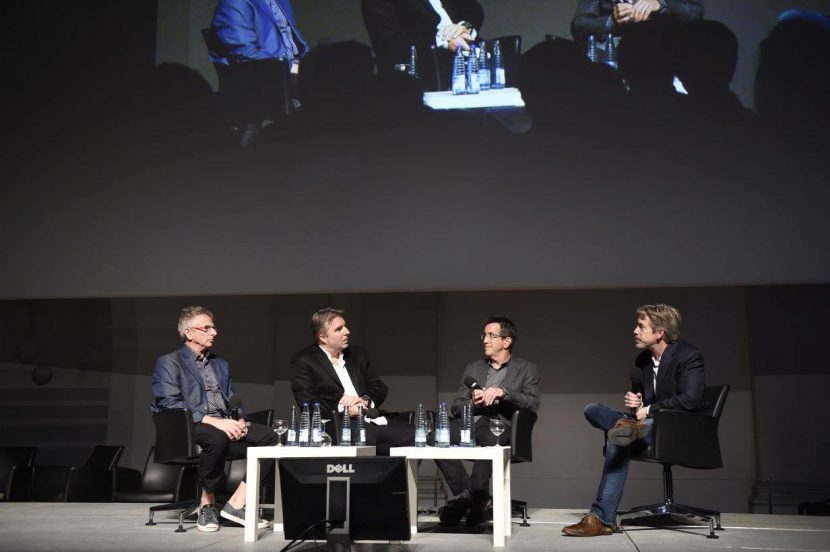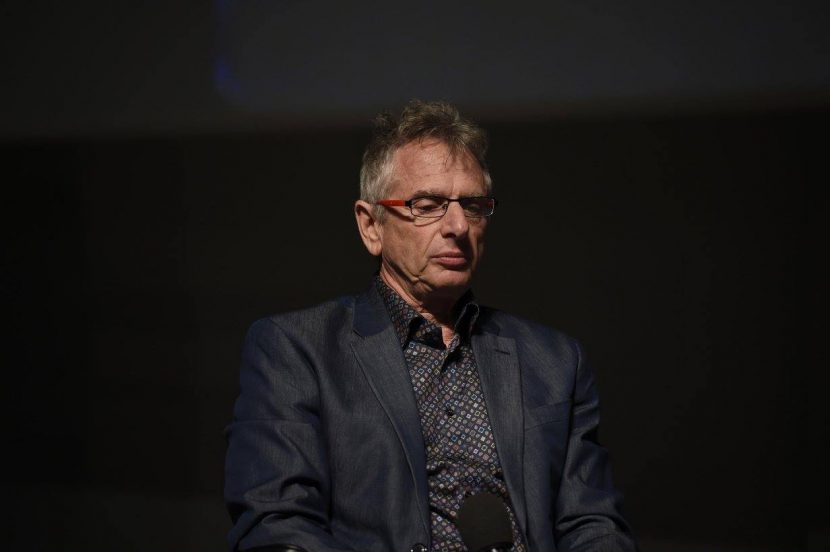At the end of last year in a story we called “A way forward for the VFX industry,” fxguide explored with VFX supervisor Ben Grossmann a new business model for the industry. Continuing on that discussion, at this year’s FMX conference Weta Digital’s Dave Gougé hosted an honest and very thought provoking panel with Warner Bros. Studios’ Chris deFaria, Method Studio’s Marc Weigert and Founder of DD and industry expert Scott Ross.
The panel discussed a variety of topics but it was over the business models that the panel really provided insight.
There were three primary models discussed.
- The first was the notion of splitting work into A and B shots such that lead artists/facilities would focus on the most complex A shots while the B shots were farmed out as a commodity.
- The second was treating VFX professionals more like ‘talent’ even going so far as to discuss agents and billing.
- The third version was a cost and material model not unlike the one that the Ben Grossmann story expanded upon.

A&B shots
The notion behind the A&B shots is that some work is now more mundane and understood thus able to be farmed out with less regard to R&D or having exceptional artists. Only the more complex and extremely complex shots would be given to any of the world’s top A grade facilities to do – but at a premium.
“We tried that a few years ago” answered deFaria, “and it didn’t work…we don’t do that anymore!” For the VFX house to be profitable while solving very complex problems, explained deFaria, they need to have the other (lower) grade work to do.
There has been a move to having multiple companies working on the VFX for a film – the roster approach of sometimes 6 or 7 companies, but deFaria explained this was due to audience testing and the huge push to keep a studio’s options open at the end of a process. As Scott Ross had pointed out earlier, “all the summer blockbusters come out in the summer,” and so a studio, deFaria explained, needed to have options to adjust and add shots based on audience testing. “Audience preview process is so important,” he explained. “We need the bandwidth to add or change 300 shots at the end of a movie.”
The tentpole studio process was explained to be centrally linked to VFX, with cast and VFX the first two things any studio focused on when deciding to green light a picture. Studios have their own teams who do detailed budgets and estimates of the VFX shots to decide on the likely budget that will be needed. Given the structure of releases and locking in release dates “we are making films for dates which means we often start films before they are ready,” said DeFaria, and as such they needed “robust tools” so that they can make any changes needed with the companies already working on the film.
Talent
For the A&B shots to even have any hope of working it was suggested that the VFX crew would need to be seen and treated as ‘talent’. daFaria was clear that he was not commenting on whether VFX crew were talented – but rather the studio use of the term ‘talent’ which meant that they were no different from actors or key creatives. At the high end, star talent can open a film and their involvement plays a key role in the marketing. While some films such as Gravity have marketed the film in part on the breakthrough VFX – it was generally agreed that individual VFX supervisors were not themselves widely enough known to be star talent and help open weekend box office on their names (and reputations) alone.
Scott Ross pointed out how ‘super’ agents such as Mike Ovitz who co-founded Creative Artists Agency (CAA) had changed the industry for actors.
But it was agreed that ‘everyone’ would need to view VFX as ‘talent’ for this to have any chance of working and deFaria asserted that “it would be very risky for a company to do it.”
The problem is that many other crafts and professions had been engaged in film making for longer and with a history of working both as guilds and with Unions in way the VFX rarely has, furthermore vfx crosses so many other disciplines, it’s role seldom looks exactly the same from one project to the next.
Scott Ross pointed out that the option of doing A&B shots at the same company also rarely worked – short term needs outweigh long term S/W R&D and perhaps a Talent and Cost plus Material model would be ideal. Ross has been a strong voice in saying the industry model we currently have is broken and it needs to be addressed. He has been fearless in speaking his mind and raising the issue of limited studios and virtually unlimited VFX houses as a fundamental imbalance.

Cost Plus Model
In this model there would need to be complete transparency. The computer animation industry was offered as such a model. With some 200 computer animated features having been made since Toy Story started the industry, the model that has evolved is much more of the Cost Plus model that exists in other industries outside the film industry.
With animated features, estimates and schedules are drawn up and then the studio tracks the project openly and constantly.
The example that was used for VFX vs. an animated feature was a director asking for a sun in a shot to be more friendly. Marc Weigert explained how hard this was to address, since the direction was so non-specific and how this sort of remark can lead to days of work trying to narrow down what is meant and find a solution. In the VFX world all too often this sort of unspecified change ends up just costing the VFX company time and thus margin. It is hard if not unpopular to ask the studio to rein in a director, and very hard to just argue with one on one with the director. deFaria pointed out this was a non-issue in animation, outlining that something would happen such as at the end of the week – during the weekly review – it would be pointed out that this or that department was 4% behind on where they were supposed to be. The team would then see why that was and then decide if they could make it up somewhere else, issue additional resources to cover it or simply ask the director to cut something else to offset the delay. deFaria went further pointing out that while animation teams do work some long hours near a deadline, on the whole they worked reasonable hours and made workable production margins.
It was also pointed out that the previs industry work on just a weekly fee – effectively cost plus.
deFaria also wanted to note for the record that some films did work well on the current system. In addition to Gravity, which had already been held up as a good experience, the film Edge of Tomorrow was made without a lot of problems, in a very well planned way and everyone seemed to have very good experiences on the production.
In somewhat of a rebuff of Ross’s earlier call for a talent and cost plus model it was outlined that the talent model is not at all transparent – the value of a star being set by a huge number of factors, vs the cost plus model which relied on complete transparency. Ross argued that DOPs and their camera crews work very successfully in the talent model without needing to be ‘George Clooney’.
The Cost plus model did seem to offer a real option for working as a new business model and while some companies fared well under the current system, the success and relative stability enjoyed by animation companies offered a tantalizing view of a VFX world beyond the current model, one in which the norm was not over work and the benefits of stability and transparency appealed to all sides of the production and effects process. But as deFaria noted, “daily transparency… just doesn’t exist in VFX”.
Dave Gougé of WETA did an excellent job in leading this panel, and hopefully this type of debate and discussion can continue to Siggraph and beyond.
In the end deFaria pointed out that most people who work in movies do so because they love them, and not because of the financials – he laughingly pointed out, “We (Warners) make much more money from HBO than movies.” Furthermore, Weigert and the panel agreed that the key to a company was being more than just one thing, “Method makes 50% of our turnover from film, but 30% from commercials and we are getting into VR, there is design, and titles, etc,” he explained and deFaria added that there was a lot of money in sports right now!
